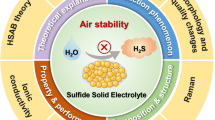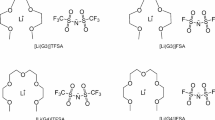Abstract
The reliability of employing beta-alumina as electrolyte for fluorine potential measurement is examined by measuring the e.m.f.s of the galvanic cells with metal/metal fluoride electrodes and comparing with those obtained by using CaF2 as electrolyte under identical conditions. The results from both types of galvanic cell can be superimposed to give the following standard Gibbs energy of formation, ΔG 0f , of FeF2 and CrF2 over extended ranges of temperature:
The absence of significant temperature-dependent errors in both these measurements are verified by a third law treatment of the data yielding values of −716.8 and −777.4 kJ mol−1 for ΔH 0f.298 of FeF2 and CrF2, respectively.
The feasibility of using beta-alumina electrolyte cells for e.m.f. measurements on other metal/metal fluoride systems is discussed in the light of the existence of a useful potential domain of beta-alumina. High sodium potential in the electrode system can lead to sodium depletion. Likewise, low sodium potential may result in oxidation of the metals in the electrodes. Both these limiting factors are also examined.
Similar content being viewed by others
References
N. S. Choudhury,J. Electrochem. Soc. 120 (1973) 1663.
T. L. Markin, R. J. Bones and V. J. Wheeler, in ‘Thermodynamics of Ceramic Systems’, Proceedings of British Ceramic Society, Vol. 8 (1967) p. 51.
E. J. McIver and S. S. Teale, UKAEA Report AERE-4942 (1965).
Yu. D. Tret'yakov and H. Schmalzried,Bern. Bunsenges Phys. Chem. 69 (1965) 213.
C. Mallika, O. M. Sreedharan and J. B. Gnanamoorthy,J. Less-Common Metals 95 (1983) 213.
C. Mallika, O. M. Sreedharan and M. S. Chandrasekharaiah,107 (1985) 203.
O. M. Sreedharan and C. Mallika,Mater. Phys. Chem. 14 (1986) 375.
O. M. Sreedharan, E. Athiappan, R. Pankajavalli and J. B. Gnanamoorthy,J. Less-Common Metals 68 (1979) 143.
W. H. Skelton and J. W. Patterson,31 (1973) 47.
W. J. Hamer, M. S. Malmberg and B. Rubin,J. Electrochem. Soc. 112 (1965) 750.
C. E. Wicks and F. E. Block, US Bureau of Mines Bulletin 605 (1965).
E. Steimmetz and H. Roth,J. Less-Common Metals 16 (1968) 295.
O. M. Sreedharan, M. S. Chandrasekharaiah and M. D. Karkhanavala,High Temp. Sci. 9 (1977) 109.
A. M. Azad, O. M. Sreedharan and J. B. Gnanamoorthy,J. Nucl. Mater. 144 (1987) 94.
S. C. Schaefer and N. A. Gokcen,High Temp. Sci. 14 (1981) 153.
S. C. Schaefer, US Bureau of Mines Report of Investigation RI 8172 (1976) pp. 1–19.
Idem, S. C. Schaefer, US Bureau of Mines Report of Investigation RI 8973 (1985) pp. 1–8.
P. A. G. O'Hare, ANL, USA, private communication.
I. Brain and O. Knacke, ‘Thermochemical Properties of Inorganic Substances’, Springer-Verlag, Berlin (1973).
O. Kubaschewski and C. B. Alcock, ‘Metallurgical Thermochemistry’, Pergamon Press, Oxford (1979) p. 258.
L. B. Pankratz, US Bureau of Mines Bulletin 674 (1984).
K. S. Pitzer and L. Brewer, ‘Thermodynamics’ (edited by G. N. Lewis and L. Randall), McGraw-Hill, New York (1967).
G. Chattopadhyay, PhD Thesis, University of Bombay (1977).
B. V. Joglekar, P. S. Nicholson and W. W. Smeltzer,Canad. Met. Quart. 12 (1973) 155.
M. Rivier and A. D. Pelton,J. Electrochem. Soc. 125 (1978) 1377.
D. J. Fray and B. Savory,J. Chem. Thermodyn. 7 (1975) 485.
F. A. Elrefaie and W. W. Smeltzer,J. Electrochem. Soc. 128 (1981) 1443.
L. Hsueh and D. N. Bennion,118 (1971) 1128.
R. Galli, P. Longhi, T. Mussini and F. A. Tropeano,Electrochim. Acta. 18 (1973) 1013.
N. K. Gupta and R. P. Tischer,J. Electrochem. Soc. 119 (1972) 1033.
A. D. Pelton, A. Dubreuil and M. Malenfant, in ‘Progress in Solid Electrolytes’ (edited by T. A. Wheat, A. Ahmad and A. K. Kuriakose). Energy, Mines and Resources, ERP/MSL 83-94 (TR), Ottawa (1983) p. 503.
M. Itoh, K. Kimura and Z. Kozuka,Trans. Jap. Inst. Met. 26 (1985) 353.
N. S. Choudhury,J. Electrochem. Soc. 133 (1986) 426.
K. T. Jacob,J. Appl. Electrochem. 13 (1983) 471.
Author information
Authors and Affiliations
Rights and permissions
About this article
Cite this article
Azad, A.M., Sreedharan, O.M. Comparative e.m.f. study of CaF2 and β-alumina cells with Ni/NiF2 and Fe/FeF2 or Cr/CrF2 electrodes. J Appl Electrochem 17, 949–955 (1987). https://doi.org/10.1007/BF01024361
Received:
Revised:
Issue Date:
DOI: https://doi.org/10.1007/BF01024361




